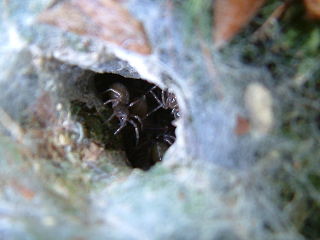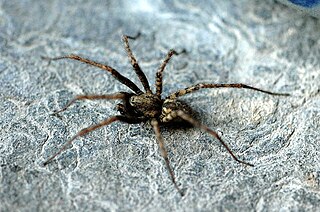
The hobo spider is a member of the family of spiders known colloquially as funnel web spiders, but not to be confused with the Australian funnel-web spider. Individuals construct a funnel-shaped structure of silk sheeting and lie in wait at the small end of the funnel for prey insects to blunder onto their webs. Hobo spiders sometimes build their webs in or around human habitations. The hobo spider lays its eggs in September and they hatch during late spring. After the male hobo spider mates it dies.

Tegenaria is a genus of fast-running funnel weavers that occupy much of the Northern Hemisphere except for Japan and Indonesia. It was first described by Pierre André Latreille in 1804, though many of its species have been moved elsewhere. The majority of these were moved to Eratigena, including the giant house spider and the hobo spider.

The spider species Tegenaria domestica, commonly known as the barn funnel weaver in North America and the domestic house spider in Europe, is a member of the funnel-web family Agelenidae.

The giant house spider has been treated as either one species, under the name Eratigena atrica, or as three species, E. atrica, E. duellica and E. saeva. As of April 2020, the three species view was accepted by the World Spider Catalog. They are among the largest spiders of Central and Northern Europe. They were previously placed in the genus Tegenaria. In 2013, they were moved to the new genus Eratigena as the single species Eratigena atrica. In 2018, the three separate species were restored. The bite of these species does not pose a threat to humans or pets, and they are generally reluctant to bite, preferring instead to hide or escape.
The name house spider is a generic term for different spiders commonly found around human dwellings, and may refer to:

The rare spider species Tegenaria silvestris is mostly found in caves, or on dumps; sometimes it occurs on forest edges, or in dry forests. It constructs its web under tree trunks and dead wood, and in tree caves.

Tegenaria ferruginea or charcoal spider is a European reddish, rather common spider with rusty markings on its back. The body looks rather similar to T. parietina, however the legs are much shorter and the funnel web built lacks backdoor exit. It was transferred to Malthonica in 2005, but back to Tegenaria in 2013.

Tegenaria parietina is a rather rare spider in Europe, with a distribution also including Northern Africa to Central Asia and Sri Lanka, and from the West Indies to Uruguay and Argentina, where it may have been introduced. In the UK it is sometimes known as the cardinal spider because of the legend that Cardinal Wolsey was terrified by this species at Hampton Court, or, conversely, because he regarded them as lucky and forbade anyone to harm them. In 2013, Tegenaria taprobanica was included in this species.

Feralia comstocki, or Comstock's sallow, is a moth of the family Noctuidae. The species was first described by Augustus Radcliffe Grote in 1874. It is found in North America from the southern Appalachians north to the Maritime provinces, east across the southern boreal forest to Vancouver Island, south to Oregon. In Alberta, the species has been collected from the Lake Athabasca and Zama areas south to about Pigeon Lake.
Acantholespesia is a genus of flies in the family Tachinidae.
Tegenaria bozhkovi is a funnel-web spider found in Bulgaria and Greece.

Eratigena is a genus of spider in the family Agelenidae. Most of its species were moved from the genus Tegenaria in 2013. Two species that frequently build webs in and around human dwellings are now placed in this genus. Eratigena agrestis is the hobo spider, native to Europe and Central Asia, introduced to North America. Eratigena atrica is the giant house spider, native to Europe and also introduced into North America.
Aterigena is a genus of funnel weavers first described by A. Bolzern, A. Hänggi & D. Burckhardt in 2010. The name is an anagram of Tegenaria. It was created in 2010 for a group of Tegenaria and Malthonica species that formed a clade in a phylogenetic analysis. The genus was later found to be monophyletic, further separating Eratigena from Tegenaria and Malthonica.
Myrmekiaphila comstocki is a spider in the family Euctenizidae, in the infraorder Mygalomorphae ("mygalomorphs"). The distribution range of Myrmekiaphila comstocki includes the USA and Mexico.

Hermetia comstocki, the agave fly, is a species of soldier fly in the family Stratiomyidae.
Acantholespesia comstocki is a species of bristle fly in the family Tachinidae. It is found in North America.
Eulasiona comstocki is a species of bristle fly in the family Tachinidae. It is found in North America.
Agathon comstocki is a species of net-winged midges in the family Blephariceridae.

Pseudococcus comstocki, common name Comstock mealybug, is a species of mealybug. The species was first discovered in 1902 in Japan. It is an invasive pest species that feeds on fruit and plants.









